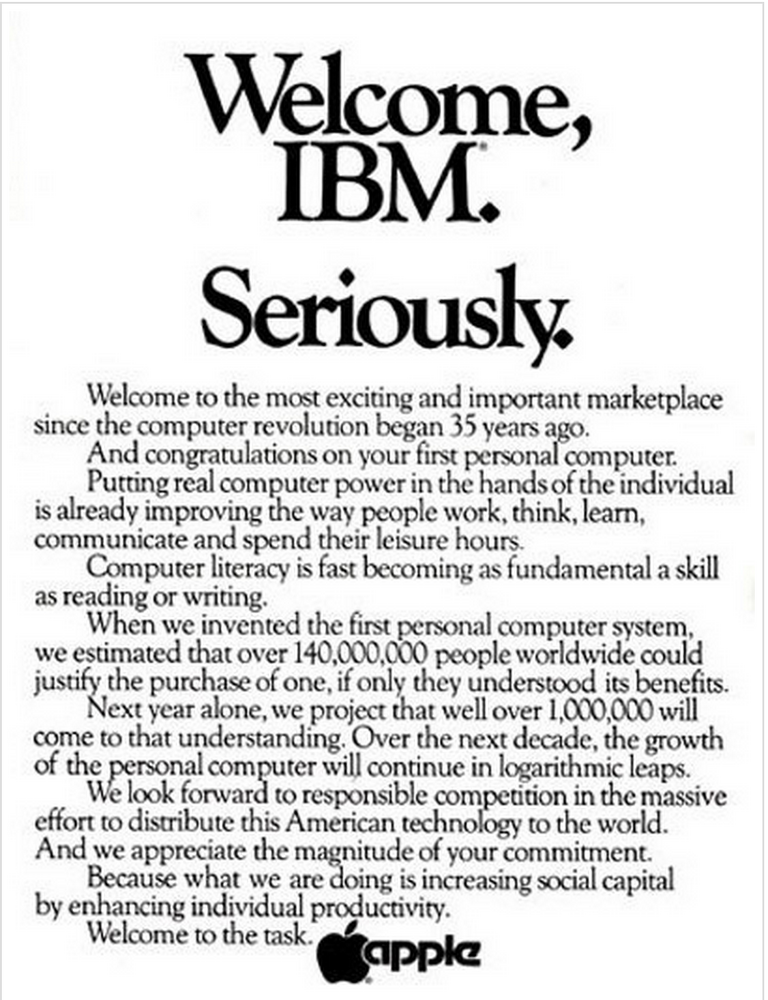40 Years of Macintosh
A (My) Personal Review
It's that time again. It's the Apple Macintosh's birthday again. It's now its 40th birthday - a special anniversary. I don't like to admit it, but most of the time in history I have somehow used the computer, or not. But read for yourself.
Before the Macintosh

After Steve Wozniak's groundbreaking tinkering, which was introduced by and as the Apple Computer in 1976, Apple sold the Apple II very successfully from 1977. The second version, the Apple II+, was released when IBM introduced its PC in 1981. With more than a wink, Apple greeted the former typewriter manufacturer with a full-page advertisement.
But by then, an important step had already been taken: Steve Jobs visited the Xerox Palo Alto Research Center (PARC) with a team for the first time in 1979 and was particularly impressed by one idea: Operating a graphical user interface with the mouse.
However, it would be another four years before the Lisa appeared as a mouse-operated computer in 1983. Although it offered groundbreaking functions such as the graphical interface and the drag & drop option, it remained commercially unsuccessful due to its high price of over $10,000.
The Origins of the Apple Macintosh

Steve Jobs, who was said to have lost interest in the Lisa, joined Jef Raskin's Macintosh project in 1981. His aim was to develop an affordable and user-friendly computer for the masses. Jobs immediately put his stamp on the team and the direction of the project, which ultimately led to a break between Jobs and Raskin.
After some delays, the time had finally come in 1984 and Apple presented its multi-award-winning commercial for the Super Bowl, which is still a milestone in advertising history today.
On January 24, 1984, the very first Apple Macintosh was released, which in retrospect became known as the Macintosh 128K. This event marked the beginning of an era that would revolutionize the world of personal computers. Steve Jobs himself said of the Mac:

Part of what made the Macintosh so great was that the people who worked on it were musicians, poets, artists, zoologists and historians who also happened to be the best computer scientists in the world."
_I remember - it must have been around 1985 - pressing my nose against the shop window of an office machine dealer in Münster. There was a Macintosh standing there playing pictures in a continuous loop. The price tag showed an amount of well over DM 7,000 - unattainable for me! Nevertheless, I tried to play around with this device as often as possible. Of course, the sales clerks quickly understood this and chased me out of the store again and again. At that time, I often spent my time in one of the local department stores and typed endless loops in BASIC on the home computers on display._
Early Successes

After its introduction, the first Macintosh received much praise from the press, but the initial sales figures quickly declined. The limited hardware, consisting of 128 KB RAM and a floppy disk drive, posed the greatest challenge. Apple continued to expand the Mac range. The Macintosh 512K, the Macintosh Plus and the Macintosh SE brought improvements in terms of memory and connectivity. The Macintosh II made it possible to display color images for the first time.
This was followed by internal power struggles at Apple, which ended with Steve Jobs leaving the company in 1985. And his self-elected CEO John Sculley became his biggest critic:

The Mac just couldn't do much: we had Mac Paint and Mac Write as the only applications, and the market had already noticed that. By the end of the year, people were saying: maybe the IBM PC isn't as easy to use or as attractive as the Macintosh. But it does something we want to do - spreadsheets, word processing, database. We saw the sales figures for the Mac go down at the end of 1984, and that became a problem the following year.“
By good luck, I suddenly got a Mac in 1988. A Macintosh SE to be precise. A printing company in Münster went bankrupt and the liquidator had no idea about the device. In a roundabout way, he offered it to me for 100 marks. Probably also because the person had problems getting it up and running due to the lack of a start disk (which was still mandatory at the time). This Macintosh SE was then my ticket into various communities, such as the Maus Muenster and also the CCC. We experimented a lot...
Troubled years
In the 1990s, Apple tried to build a computer for every taste with an almost unmanageable range of models. There was hardly anyone left who understood the division into Performa, LC, Classic, Quadra or Centris - not to mention the mobile devices.
From 1994, the licensing of Macintosh OS to third-party manufacturers was intended to increase market share, but this ultimately led to lower profits. The license fee of 50 US dollars was simply too low, because the company's own hardware sales were cannibalized more than its own sales were increased.
One ray of hope was Apple's collaboration with IBM and Motorola, or AIM for short. The introduction of the PowerPC 601 chips was a pioneering achievement in terms of speed. 1999 was also the year in which PowerMac was used on the case for the first time. The term "Macintosh" was dropped. But the speed of the computer was not the only construction site.
At the same time, it became apparent that the classic Mac OS was outdated. Despite several attempts to develop a modern alternative, Apple initially failed to do so. Many people don't like to remember the time with Copland. I remember an early lecture I gave:

Apple has always given its projects code names. The old MacBooks had street names and were called Lombard or Wallstreet. The system software was named after composers such as Mozart or Beethoven. With Copland, they wanted to emphasize the new beginning and chose Aaron Copland as the namesake. With Mac OS X, it was the turn of cats of prey, and today, beautiful landscapes are the names of choice.“
The problems at Apple were accompanied by a drop in computer prices - and that was my chance. In quick succession, I was able to afford a Performa 630, which was practically thrown at me at Hobbytronic (a local German computer fair) in Dortmund. Later, I got a PowerBook G3 Wallstreet. My old Macintosh SE was upgraded to an SE/30 with a 20MB hard disk. I then had my first experience with Apple Unix A/UX.
Apple Takes Over NeXT

In December 1996, Apple took over the company NeXT. This gave Apple not only a modern and UNIX-based operating system, but also Steve Jobs back. Jobs started a comprehensive reorganization of the company. The board was dismissed and Gil Amelio, the CEO at the time, resigned. Steve Jobs became interim CEO, iCEO for short. I spoke in a lecture:

The second potential acquisition candidate, Be Inc. with its BeOS, is also often mentioned in this context. Apple could have bought this company for significantly less money - for 275 million dollars instead of the 429 million dollars for NeXT. But Be couldn't win the race because the operating system landscape was very special at the time. On the one hand, there was MS-DOS with the (then still) graphical Windows add-on. But the UNIX movement was much bigger at the time. Many companies had their own derivative of AT&T UNIX. This included NeXTStep with its Mach kernel, which was a derivative of BSD UNIX. BeOS on the other hand, was its own proprietary - albeit very open - system. And that was of course a problem for Apple. After all, they had just hit the wall with a proprietary system. In addition, a certain Linus Torvalds had been sending regular messages to the world about his developments called Linux since 1991.“
Triggered by my first experiences with A/UX, I was fully infected by Unix & Linux fever. I gained my experience on an old 386 PC with a 0.9 version of Linux. There must have been 20 floppy disks for the installation. Nevertheless, I always had a Macintosh on my desk. This was used for work; the Linux PC was for learning.
Mac OS X, OS X & macOS
In the years following the takeover - or was it more of a merger - Apple's development team worked with the leading minds at NeXT to transform the operating system into something completely new. Even though the first versions of Mac OS X were still very difficult to use, the underlying potential quickly became apparent. Over the years and versions, OS X (as it was called before it was renamed macOS) got better and better. When Steve Jobs presented the new interface back then, he raved about it:

We have designed the buttons on the screen for Aqua so beautifully that you want to lick them.“
Well, his reality distortion field didn't quite reach that far for me. In 2000, I was trapped in a large corporation and had to work with Windows. Two facts that displeased me and led to the launch of ProjectWizards in 2002. But before that, the ILOVEYOU virushad to happen; the decisive point as to why we work with the Mac. But here begins a completely different story, which also has an anniversary later this year.
Anniversary Mac
Admittedly, Apple tried it once before in 1997 with the Twentieth Anniversary Macintosh (TAM). Based on the PowerPC and with a very special design, it was unsuccessful - probably mainly due to the high price of $7,499.
Nevertheless, there are increasing rumors that Apple will bring out another special edition to celebrate the 40th anniversary. It is to be a MacBook Pro. This special edition will not only be technologically advanced, but also reminiscent of the original Macintosh. Whether this will only be the color of the case or something else; we'll find out on January 24, 2024 and I'll report back here.
Update on January 24, 2024: Apple has not released a special anniversary Mac. A pity, really...
My Conclusion
Four decades after its introduction, the Macintosh remains an important part of the Apple portfolio. From its beginnings as a pioneer of graphical user interfaces to today's powerful Apple Silicon-based models, the Macintosh has undergone an impressive evolution. The Mac OS X provides the basis for the iPhone and the iPad.
Its influence on the world of personal computers is undisputed and will continue in the future - and not just at ProjectWizards.

